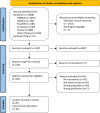Workplace interventions to prevent suicide: A scoping review
- PMID: 38696511
- PMCID: PMC11065308
- DOI: 10.1371/journal.pone.0301453
Workplace interventions to prevent suicide: A scoping review
Abstract
Objectives: To map organisational interventions for workplace suicide prevention, identifying the effects, mechanisms, moderators, implementation and economic costs, and how interventions are evaluated.
Background: Suicide is a devastating event that can have a profound and lasting impact on the individuals and families affected, with the highest rates found among adults of work age. Employers have a legal and ethical responsibility to provide a safe working environment for their employees, which includes addressing the issue of suicide and promoting mental health and well-being.
Methods: A realist perspective was taken, to identify within organisational suicide prevention interventions, what works, for whom and in what circumstances. Published and unpublished studies in six databases were searched. To extract and map data on the interventions the Effect, Mechanism, Moderator, Implementation, Economic (EMMIE) framework was used. Mechanisms were deductively analysed against Bronfenbrenner's socio-ecological model.
Results: From 3187 records screened, 46 papers describing 36 interventions within the military, healthcare, the construction industry, emergency services, office workers, veterinary surgeons, the energy sector and higher education. Most mechanisms were aimed at the individual's immediate environment, with the most common being education or training on recognising signs of stress, suicidality or mental illness in oneself. Studies examined the effectiveness of interventions in terms of suicide rates, suicidality or symptoms of mental illness, and changes in perceptions, attitudes or beliefs, with most reporting positive results. Few studies reported economic costs but those that did suggested that the interventions are cost-effective.
Conclusions: It seems likely that organisational suicide prevention programmes can have a positive impact on attitudes and beliefs towards suicide as well reducing the risk of suicide. Education, to support individuals to recognise the signs and symptoms of stress, mental ill health and suicidality in both themselves and others, is likely to be an effective starting point for successful interventions.
Copyright: © 2024 Hallett et al. This is an open access article distributed under the terms of the Creative Commons Attribution License, which permits unrestricted use, distribution, and reproduction in any medium, provided the original author and source are credited.
Conflict of interest statement
The authors have declared that no competing interests exist.
Similar articles
-
Why do acute healthcare staff behave unprofessionally towards each other and how can these behaviours be reduced? A realist review.Health Soc Care Deliv Res. 2024 Aug;12(25):1-195. doi: 10.3310/PAMV3758. Health Soc Care Deliv Res. 2024. PMID: 39239681 Review.
-
Are Young Men Getting the Message? Age Differences in Suicide Prevention Literacy among Male Construction Workers.Int J Environ Res Public Health. 2019 Feb 6;16(3):475. doi: 10.3390/ijerph16030475. Int J Environ Res Public Health. 2019. PMID: 30736304 Free PMC article.
-
Interventions aimed at preventing suicide in the healthcare workforce: a systematic review.Nurs Manag (Harrow). 2025 Feb 6;32(1):19-25. doi: 10.7748/nm.2024.e2132. Epub 2024 Jul 30. Nurs Manag (Harrow). 2025. PMID: 39075928
-
Prevention of relapsing backache.GMS Health Technol Assess. 2006 May 24;2:Doc12. GMS Health Technol Assess. 2006. PMID: 21289963 Free PMC article.
-
Causes and solutions to workplace psychological ill-health for nurses, midwives and paramedics: the Care Under Pressure 2 realist review.Health Soc Care Deliv Res. 2024 Apr;12(9):1-171. doi: 10.3310/TWDU4109. Health Soc Care Deliv Res. 2024. PMID: 38662367 Review.
Cited by
-
'From that time onwards my role changed'. Disclosing suicidality in Australian workplaces a qualitative study.Health Promot Int. 2025 Mar 5;40(2):daaf017. doi: 10.1093/heapro/daaf017. Health Promot Int. 2025. PMID: 40208188 Free PMC article.
-
MATES in Manufacturing: A Cluster RCT Evaluation of a Workplace Suicide Prevention Program.Am J Ind Med. 2025 Apr;68(4):331-343. doi: 10.1002/ajim.23698. Epub 2025 Jan 12. Am J Ind Med. 2025. PMID: 39800439 Free PMC article. Clinical Trial.
-
Occupational Injury and Suicide in Washington State, Adjusting for Pre-Injury Depression.Am J Ind Med. 2025 Feb;68(2):122-131. doi: 10.1002/ajim.23682. Epub 2024 Dec 17. Am J Ind Med. 2025. PMID: 39690720
References
-
- World Health Organisation. Suicide worldwide in 2019. Global Health Estimates Geneva: World Health Organisation; 2021. [cited 2023 23 January]. Available from: https://www.who.int/publications/i/item/9789240026643.
-
- Office for National Statistics. Suicide in England and Wales: 2020 registatrations 2020 [cited 2022 13 July]. Available from: www.ons.gov.uk/peoplepopulationandcommunity/birthsdeathsandmarriages/dea...
-
- Solin P, Tamminen N. Scoping review of good practices of suicide prevention in the European region. European Region Journal of Psychological Studies. 2020;2(1):103.
Publication types
MeSH terms
LinkOut - more resources
Full Text Sources


